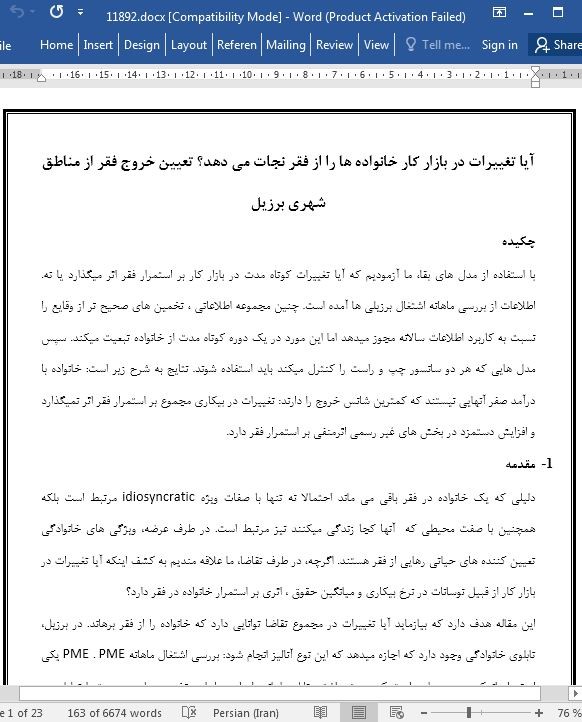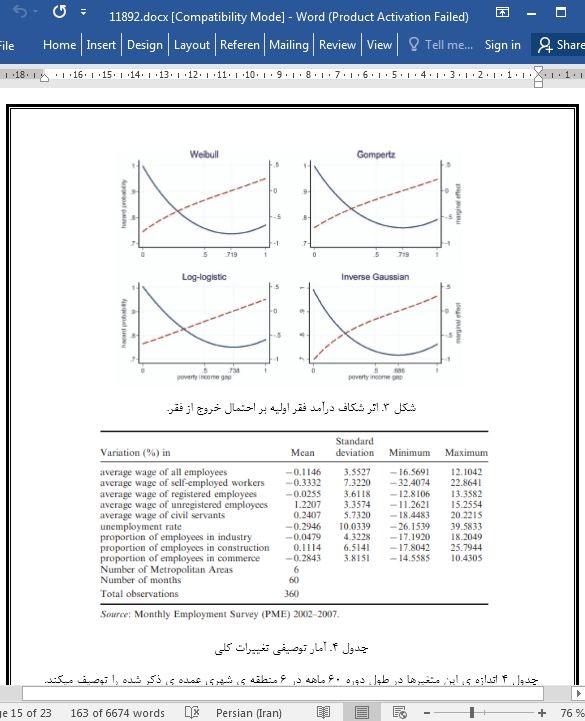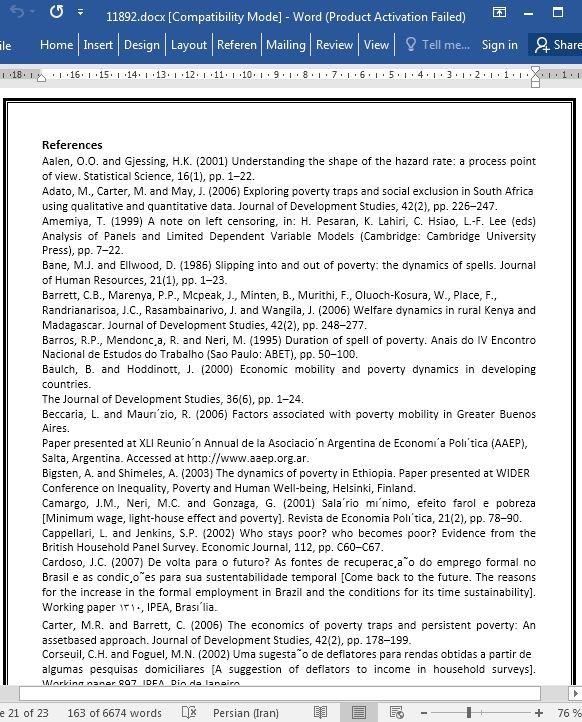
آیا تغییرات در بازار کار خانواده ها را از فقر نجات می دهد؟
چکیده
با استفاده از مدل های بقا، ما آزمودیم که آیا تغییرات کوتاه مدت در بازار کار بر استمرار فقر اثر میگذارد یا نه. اطلاعات از بررسی ماهانه اشتغال برزیلی ها آمده است. چنین مجموعه اطلاعاتی ، تخمین های صحیح تر از وقایع را نسبت به کاربرد اطلاعات سالانه مجوز میدهد اما این مورد در یک دوره کوتاه مدت از خانواده تبعیت میکند. سپس مدل هایی که هر دو سانسور چپ و راست را کنترل میکند باید استفاده شوند. نتایج به شرح زیر است: خانواده با درآمد صفر آنهایی نیستند که کمترین شانس خروج را دارند: تغییرات در بیکاری مجموع بر استمرار فقر اثر نمیگذارد و افزایش دستمزد در بخش های غیر رسمی اثرمنفی بر استمرار فقر دارد.
1- مقدمه
دلیلی که یک خانواده در فقر باقی می ماند احتمالا نه تنها با صفات ویژه idiosyncratic مرتبط است بلکه همچنین با صفت محیطی که آنها کجا زندگی میکنند نیز مرتبط است. در طرف عرضه، ویژگی های خانوادگی تعیین کننده های حیاتی رهایی از فقر هستند. اگرچه، در طرف تقاضا، ما علاقه مندیم به کشف اینکه آیا تغییرات در بازار کار از قبیل نوسانات در نرخ بیکاری و میانگین حقوق ، اثری بر استمرار خانواده در فقر دارد؟
نتیجه
نتایج مدل های بقای پارامتری پیشنهاد میکند که احتمال حرکت به خارج از فقر، طول مدت ماندن در فقر را عمدتا بعد از ماه دوم در این شرایط کاهش میدهد. بنابراین، هر چه خانواده ها بیشتر در فقر بمانند، شانس بیشتری دارند که در آن باقی بمانند.
با توجه به خانواده هایی که وارد فقر شدند، ما دریافتیم که به طور کلی، هر چه فاصله ی درآمد سرانه ی اولیه خودشان زیر خط فقر باشد، احتمال خروج آنها از فقر کمتر است. اگرچه، خانواده هایی که بدون درامد یا با درآمد بسیار کم به فقر وارد میشوند، آنهایی نیستند که با کمترین شانس خروج از این حالت را دارند. برای برخی خانواده ها ، طبیعت زودگذر بیکاری رییس خانواده یا سایر اعضای کار کلیدی آنها را در این موقعیت قرار میدهد که شکاف درآمد فقر آنها احتمالا بزرگ است اما احتمال باقی ماندن در فقر کمتر از ان خانواده هایی است که درآمدهای بالاتری دارند اما درآمد فقر آنها دوام بیشتری دارد.
ABSTRACT
Using survival models, we test whether short-term changes in the labour market affect poverty duration. Data are from the Brazilian Monthly Employment Survey. Such a monthly dataset permits more accurate estimations of events than using annual data, but its panel follows households for a short period. Then methods that control for both right- and left-censoring should be used. The results are as follows: households with zero income are not those with the lowest chances of exiting; changes in aggregate unemployment do not affect poverty duration; and increasing wages in the informal sector has a negative effect on poverty duration.
I. Introduction
The reasons that a family remains in poverty may be associated not only with its idiosyncratic features but also with characteristics of the environment where it lives (Adato et al., 2006; Carter and Barrett, 2006; Hoddinott, 2006). On the supply side, household characteristics are the critical determinants of leaving poverty. However, on the demand side, we are interested in discovering whether changes in the labour market, such as fluctuations in the unemployment rate and the average wage, have any effect on the duration of households in poverty.
VI. Conclusion
The results of the parametric survival models suggest that the probability of moving out of poverty decreases the longer the household has remained in poverty – mainly after the second month in this condition. Therefore, the longer the household stays in poverty, the greater the chances that it will remain there.
With regard to households that have entered poverty, we found that, in general, the greater the distance of their initial per capita income below the poverty line, the lower the probability of their exit from poverty. However, the households that entered into poverty with no income, or very low incomes, are not the ones with the lowest chance of exiting this state. For some households, the transitory nature of unemployment of the household head or other key working members puts them in the situation where their poverty income gap might be large but the probability of remaining in poverty is actually lower than that for households that have somewhat higher incomes but their poverty-level income is long-lasting.
چکیده
1- مقدمه
2- در طول دور فقر و در حرکت به بیرون از فقر: مرور کوتاهی از تاریخچه
3- اطلاعات
نسبت دادن درآمد غیرکار در PME
نمونه گیری و توصیف متغیرها
4- قالب کار تجربی: مدل های بقا
5- نتایج:
شیب عملکرد احتمالات (خطر)برای خروج از فقر
عوامل تعیین کننده خروج از فقر
اثر تغییرات بازار کار بر خروج فقر
نتیجه
نکته ها
منابع
ABSTRACT
I. Introduction
II. Duration In and Mobility Out of Poverty: a Brief Review of the Literature
III. Data
Imputation of Non-labour Income in the PME
Sample and Description of Variables
IV. Empirical Framework: Survival Models
V. Results
The Slope of the Probability (Hazard) Function for Exiting Poverty
The Determinants of Leaving Poverty
The Effect of Labour Market Changes on Exiting Poverty
VI. Conclusion
Acknowledgements
Notes
References
- ترجمه فارسی مقاله با فرمت ورد (word) با قابلیت ویرایش، بدون آرم سایت ای ترجمه
- ترجمه فارسی مقاله با فرمت pdf، بدون آرم سایت ای ترجمه



